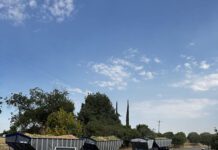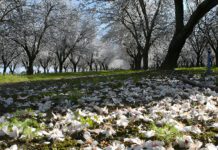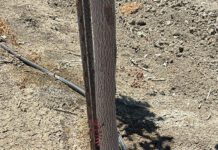We “West Coast Nut” growers (see what I did there?) invest, work, pray, work, hope and work some more for three to seven years before we even get our first crops to harvest. And now it’s upon us, the “fruit” of our labor. Especially in California, where the ground shakes almost as much as our orchard harvesting equipment, we rattle our babies until they let loose of our most prized farming possessions—our nuts. As much as that’s a necessity to make farming profitable, harvesting takes its toll on our trees. This year seems to be playing out a little differently than most and we need to keep the changes in mind.
Your trees have worked hard to produce. We fed them early and often as they put out their solar panels and raced through pollination. Early nutrition came from root storage and sequestered nutrition trapped in the spurs. As transpiration increased, we hit the roots hard and added foliar nutrition to orchard health prevention and suppression sprays. Managing nitrogen with balanced P, K, Ca, Mg, S and minors, we worked hard to balance our trees’ food to optimize nut fill and yield. We battled through heat stress, managed water and timing to keep our orchards as healthy as possible. Now we need to realize that we were only the coaches. Our trees did the real work. And here we are….harvest.
Focus on Foliars
The world has been tipped on its head. Atlas is straining, hard. The almond world is seeing its biggest crop ever as the entire world is trying to figure out how it is going to be able to acquire that crop. The uncertainty of delivery and volume of nuts we will need to store has made future prices fall this year. In many cases, that has led to a tightening of the nutrition budget. Here comes the perfect storm. The biggest crop ever, potentially for pistachios and walnuts as well, and no price. When this happens and nutrition gets the axe, we greatly inhibit next year’s crop potential. All those babies were produced, and no food for next year’s buds. Combine that with a further budget reduction in post-harvest nutrition and we run the risk of a catastrophe next year: no crop and lower prices.
“Okay coach, what now?” Focus. Pay very close attention to those July and August tissue numbers.
Make sure your trees are hydrated soon after and/or during harvest depending on your crop. Trees don’t assimilate nutrition well if they are dehydrated, especially foliarly. Get them recovered with water and then feed them.
Micronutrients can be addressed well with foliar sprays, but make sure your tank water has been dropped to acidic levels. Foliar nutrition with micronutrients applied properly can go many times farther than the same soil-applied nutrients.
Plant-Ready Ca and P
In the second irrigation after harvest, capture that big root flush. Add soluble and plant-ready calcium for cell division. With all the potassium added during heat stress and nut fill, we are probably calcium deficient in our younger tissues. With much of that calcium going to root production, more will be needed for new foliage and buds. However, it has to be plant ready. Insoluble calcium salts will not feed a plant or even displace sodium. It has to split into its ionic form to be assimilated and stick to binding sites.
In my humble opinion, I’d address plant-ready phosphorus next. Those trees just ran a marathon; they are going to need help producing energy, and adequate P is required to make that happen. However, here are three things to think about: 1) make sure it’s orthophosphate so it’s plant ready; .) don’t overdo it with too much P (what can’t be assimilated will tie up calcium); and 3) add a good chelator like humic acid to keep combinable nutrients separate and provide a good carbon source. The extra carbon will feed the soil biology, keep the soil wetter longer and grab other nutrients that may become etched off the soil colloid. Feeding the soil biology will also exacerbate nutrient transformation as they eat and respire.
If you were deficient in magnesium at all, it can be applied both through the irrigation or in a spray. Magnesium is critical right now for carbohydrate production to create adequate chlorophyll levels. If we can store more carbohydrates in the fall, we give our trees a better chance to produce big yields again next year.
Doing More with Less
Don’t forget to drop the pH. A little acidity will go a long way. Keep the irrigation water as close to 6.0 pH as possible. This will solubilize as much nutrition as possible and mine what’s still in the soil and tied up. Try to use more acidic nutrients: elemental sulfur, boric acid, magnesium acid, sulfuric acid, acidifiers, ammonium sulfate, citric, lactic, etc. There are even stories of industry legends adding vinegar to their spray rigs to drop pH. Do whatever it takes to hedge your bet. Remember, it’s not what you put on your trees, it’s what you get into your trees that matters.
Logistically, it can be very difficult to get more nutrition into your trees with less. But a careful eye on irrigation rates when fertigating will help. Shorter irrigation sets when fertigating will keep nutrition in the flushing feeder roots. Adjust pH when spraying is critical. Check your water. A couple sprays addressing different nutrients in each will help as well.
If it gets difficult to get across a lot of acres post-harvest, many nutrients can be applied with only 10 gallons of water by air. Hire it out. It’ll save critical time and labor for about the same cost. Adding a little nutrition to each irrigation after that first one all the way through dormancy can greatly enhance tree health. Specifically addressing complimentary nutrients in adequate, soluble and non-excessive rates should go a long way. Not over-doing it will keep that nutrition from tying up. Our trees just ran their marathon. Be a good coach and help them recover. Don’t put them to bed hungry and you’ll both be rewarded with a good crop again at next year’s finish line.
















